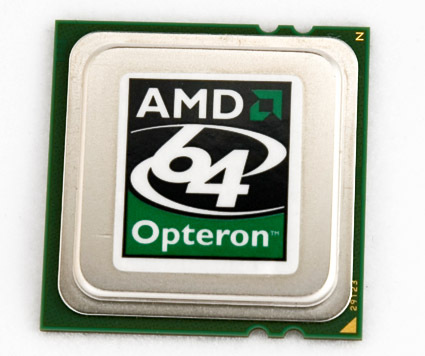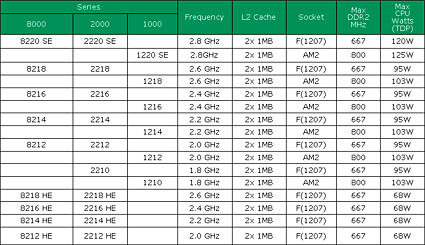AMD intros new Opterons and promises 68W quad-core CPUs
Sunnyvale (CA) - AMD today unveiled its first answer to Intel's Core micro architecture. An updated version of the processor that is driving the firm's revenue growth and market share gains claims to not only close the gap to "Woodcrest" but even surpass it in speed and power consumption. And then there is the promise that quad-cores won't consume more power than today's dual-cores.
AMD's new Opteron processors are based on the new Socket AM2 - which has been introduced earlier for Sempron and Athlon desktop CPUs - and Socket F. In total, there are 23 new dual-core CPUs - which do not represent a radical departure from the previous product generation, but a rather evolutionary step for AMD to upgrade the processor that has been challenging Intel in the server and workstation market so successfully in recent months.
On the surface, there are still three Opteron series processors - the "8" series for up to 8P systems, the "2" series for up to 2P systems and the "1" series for 1-way servers and workstations. But the new chips carry a four-digit model number instead of the three-digit number of their predecessors. According to AMD, the number explains the scalability, the socket generation as well as the relative performance within the series. For example, model 2216 (2.4 GHz) is two-way capable (first "2"), carry the second generation socket (second "2") and run faster than the 2214, but slower than the 2218.
AMD's new Socket F Opteron processor
All new regular 8P and 2P processors based on the Socket F are rated at a thermal design power of 95W; 1P (Socket AM2) versions run at 103W. Socket F models ranging from 2.0 GHz (XX12) to 2.6 GHz (XX16) are also available in a low-power "HE" version that is rated at a TDP of only 68W and closely matches Intel's Woodcrest processor rating (65W to 80W). Next to the mainstream (95W-103W) and low-power (68W) processors, AMD is also offering a 2.8 GHz high-end model: The 1220 SE and 8220 SE - think "sport edition" - will ask for 125W and 120W, respectively.
Overview of all 23 new Socket F and AM2 Opteron processors
Compared to Intel's sparkling new micro architecture, AMD's new Sockets almost look a bit bland. Yes, there is support for DDR2 memory - 667 MHz for F and 800 MHz for AM2 - and there is AMD's virtualization feature, previously code-named "Pacifica" and now officially introduced as "AMD-V." The question, however, is if that will be enough to maintain the firm's current momentum against Intel's much praised Core architecture.
Get Tom's Hardware's best news and in-depth reviews, straight to your inbox.
In a conversation with TG Daily, AMD representatives were very confident that the Opteron is the better processor from several perspectives. First, AMD says that the Socket F CPUs can beat Woodcrest (Xeon 5100 series) in at least one benchmark (SPECfp_rate2000 (Linux) by 11%. Second, the firm claims that it is still offering the most power-efficient processor - if not only the processor's power requirement is considered, but the power of the memory and Northbridge as well. And third, AMD tells its customers that it has a history of offering more consistent platforms with less dramatic changes and the opportunity to keep fine-tuned applications and to easily upgrade to the upcoming quad-core generation.
Interestingly, AMD apparently has changed its policy to not release detailed information about future processors: Intel's Woodcrest may have convinced AMD to talk more about its quad-core processors, even if they will not be released for another ten to twelve months. According to AMD, the new AM2 and F Opterons lay the foundation for a "seamless" migration to quad-core: Designed as a drop-in update, the future CPU is promised to be a "native quad-core", will run the "full" speed of the Hypertransport link (200 MHz x 5) and consume the same power as today's dual-core processors: AMD confirmed to TG Daily that it will be offering a 68W quad-core processor. It is unclear at this time how much power Intel's quad-core "Clovertown" processor will consume, but industry sources told TG Daily that the CPU's TDP will jump to 110W for a 2.67 GHz processor.
Which processor in fact is faster and more power-efficient may depend on customer applications in most scenarios, at least in 1P and 2P environments. For multi-socket 4P and 8P systems, AMD has still a clear edge over Intel's "Dempsey" processor (Xeon 7000 series), which is still based on the old Netburst architecture. AMD claims that its 8220SE is about 47% faster than Intel's Xeon 7041 in a 4P configuration and may use 27% less power in such a scenario.
According to AMD, all new Socket F and AM2 Opterons are available now and are available from $255 (model 1210, 1.8 GHz) to $2649 (8220 SE, 2.8 GHz).
Related article:
Woodcrest launches Intel into a new era
AMD unleashes AM2 processor series
Tom's Hardware is the leading destination for hardcore computer enthusiasts. We cover everything from processors to 3D printers, single-board computers, SSDs and high-end gaming rigs, empowering readers to make the most of the tech they love, keep up on the latest developments and buy the right gear. Our staff has more than 100 years of combined experience covering news, solving tech problems and reviewing components and systems.




